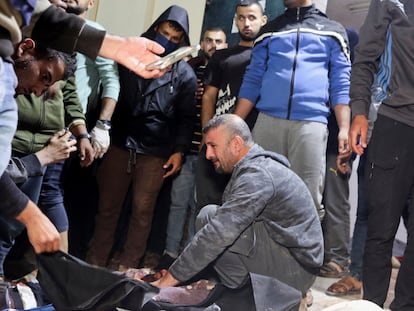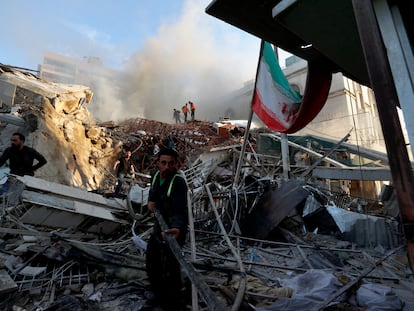War plunges Israeli agriculture into the greatest crisis in its history
Crops are rotting near Gaza and Lebanon. Authorities are rushing in workers from India, Malawi and Sri Lanka to make up for the departure of Thais, the ban on Palestinians and the draft of Israelis

Amos Trabelsey suggests that we put aside our shyness and pluck all the tomatoes we want from the vines. “They are going to end up rotting, otherwise. There is no one to pick them,” he says with more pragmatism than self-pity in his now empty greenhouse in the moshav (agricultural cooperative) Sharsheret, located around nine miles (14 km) from Gaza on a long plain considered “the orchard of Israel.” About 45 people used to work for this small agricultural business until the Hamas attack on October 7, which reached the gates of Sharsheret and changed everything.
Thousands of foreign workers (mainly Thais, but also Nepalis and Tanzanians) returned to their country after the murder and kidnapping of dozens of their compatriots. Palestinian day laborers — the other key workforce — saw their entry permits revoked (residents of Gaza) or paused (those of the West Bank). And many Israelis who worked in agriculture were evacuated to other parts of the country or called up as reservists. All the missing people have created a landscape filled with empty land, parked tractors and a silence that allows the nearby bombings to be heard even more clearly, illustrating “the biggest crisis for agriculture in the State of Israel since its creation” in 1948, as defined in parliament by Oren Lavi, director general of the Ministry of Agriculture and Rural Development.
The government is trying to fill the void with volunteers, financial incentives for anyone willing to risk working near Gaza or Lebanon (where the largest number of mortar shells fall) and, above all, by rushing in fresh labor, mainly from India, Malawi and Sri Lanka. This has notably compensated for the absences, but the workers’ conditions are a source of concern for human rights associations. An Indian worker was killed earlier this month by an anti-tank projectile fired by the Hezbollah militia. The attack took place in a border area evacuated of residents for safety, but where he and other Indians and Thais had been hired to work in an orchard.
Trabelsey, 66, shows the dead branches on the tomato vines and the empty spaces that he would normally be preparing for eggplants and peppers. The sowing, care and harvesting cycles, he explains, have strict schedules that fit very poorly with the uncertainty of a war that has already exceeded five months and has no clear end.
“For this we need about 30 people. I can’t do it alone,” he says. Five workers have just arrived from Malawi. Hosea Tchawango, 34, takes a break from work to say that he learned about the job opportunity at his local church. “Before arriving, I wasn’t sure I was going to work so close to Gaza,” he admits. “I did know that I was coming to a war zone… Anyway, they have guaranteed that it is safe and I believe them,” he says with more hesitation showing in his eyes than in his words. In Malawi, he adds, he earned 200,000 kuachas (about $118) per month; here, he makes about 6,000 shekels ($1,600).

The area around Gaza — fertile and dotted with kibbutz like those attacked on October 7 — is small, but it accounts for 25% of the national crops. In some products, its weight is even bigger: 60% of the country’s potatoes, 57% of the barley, 47% of the tomatoes and 38% of the cabbages came from there. Their prices have risen in supermarkets, but they are not out of control.
“Without new workers, it will be the end”
Ilan Yojanan continues working at the Ein Habsor moshav, four miles from Gaza, despite the memory of fighting that day with Palestinian militiamen — who shot at him with grenade launchers — to prevent them from entering. The business is operating at 40% of activity due to a shortage of workers. Only seven of the 32 Thais who grew lettuce here have stayed. The cooperative has also been operating thanks to the work of Israeli volunteers and, for a month and a half, also of Sri Lankan day laborers. “If the volunteers hadn’t come, I would be bankrupt already. But, honestly, if new workers don’t arrive soon, it will be the end. I ask the volunteers for more technical work, maintenance things, because there are tasks that may seem easy from the outside, but they are not. It is very physically tough to plant lettuce for someone who has never done it in their life,” he points out.
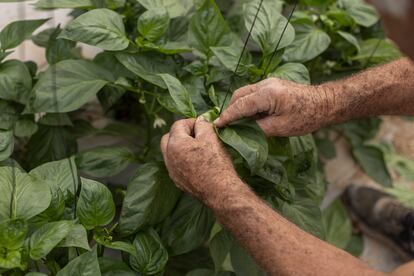
Nurit Gil, 42, does know how to plant lettuce, although she is more used to organizing groups to protest against Israeli Prime Minister Benjamin Netanyahu, so for five months she has been coordinating a minibus of volunteers, like herself, to help the growers. They got up early to get here from Tel Aviv and they assemble the vines in the greenhouse with more goodwill than skill. At first, the government financed their transportation; now, the expenses are being borne by a nonprofit named Lev Ehad. “Like all of Israel, on October 8 I was in a state of panic. I had the activist instinct to do something, also for my mental health,” she says at the end of the day. Gil admits that her contribution is “quite small,” but notes the farmers’ gratitude. “I am very critical of what the army is doing in Gaza and I feel the need to give something to society, so this is my battle.” She has the time because she is an architect and war has slowed down construction.
Before the war, 29,900 foreign workers were employed in Israeli agriculture; the majority were from Thailand. At the beginning of the war, nearly 10,000 returned to their countries of origin. In addition, between 10,000 and 12,000 Palestinians were banned from entering Israel. Meanwhile, hundreds of thousands of Israelis were recruited as reservists, “did not show up for work out of fear” or were evacuated to other parts of the country, making it “very difficult for them to get to their workplace,” said a source at the ministry.
Authorities have taken measures that some farmers see as temporary patches. On the one hand, a bilateral agreement with Sri Lanka. In other countries, they hired about 3,000 people through private personnel companies. In addition, the government temporarily eliminated the five-year stay limit for foreign workers. Normally, when they reach that limit, foreign workers have to leave (or stay illegally), following a policy aimed at maintaining the Jewish demographic majority. For Israelis working in border areas, there is an incentive of 2,000 shekels ($536). It is estimated that there are now the same number of foreign workers as before the war, but the Palestinians and Israeli workers are still missing.
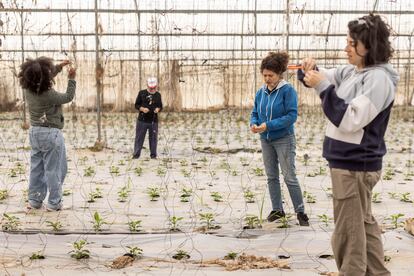
Nationalism is also being used as a factor. Supermarkets show off fruits and vegetables marked with the national flag and messages encouraging people to buy Israeli products. “I don’t want the consumer to have to hesitate between a tomato from the Arava [southeast of Israel] or from Turkey,” Lavi said in parliament, after Turkish President Recep Tayyip Erdogan went from looking for a date for an official visit by Prime Minister Benjamin Netanyahu ― weeks before the war ― to describing the Israeli leader as “worse than Hitler.”
Ayal Kimhi, a professor of agricultural economics at the Hebrew University of Jerusalem and vice president of the Shoresh Institution for Socioeconomic Research, recalls that the sector also suffered in the Golan Heights (Syrian territory occupied by Israel since 1967) in the 1973 Yom Kippur War, and by the closures to the access of Palestinian workers, especially during the Second Intifada (2000-2005), but he said that it has never experienced a crisis quite like the current one. His real fear, however, is that the situation might be prolonged — not because of the impact on the economy, since agriculture, as in other developed countries, barely accounts for 2% of GDP, but because of food security. “The Covid pandemic already highlighted its importance. And Israel cannot depend on a country like Turkey deciding to stop exports in a situation like this one,” he points out. “Bringing workers from other countries is not a long-term solution.”
Symbolic importance
Agriculture, an important economic sector in Israel right after its creation, has lost a lot of weight since then, but retains an important symbolic dimension: Zionist pioneers praised the work of the land (which Jews were prohibited from owning in Europe for centuries) in posters, where they portrayed “the new Jew”: determined, muscular and holding a hoe in his hand.
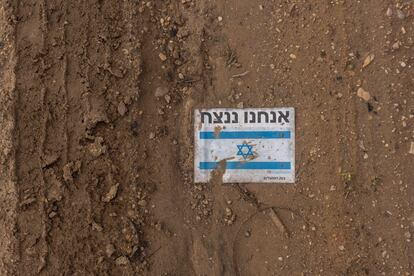
The crisis is not only affecting the area known as the “orchard of Israel.” Also affected is the border with Lebanon, the area with the most evacuees (about 80,000). This zone is home to 40% of deciduous and subtropical fruit crops, mainly avocados, wine grapes, plums and mangoes, according to data from the Ministry of Agriculture. Shells fall there every day, in a growing conflict between Israel and Hezbollah that is overshadowed by the magnitude of the destruction and hunger in Gaza.
On March 4, one of these shells killed a foreign worker dispatched in a hurry to save Israel’s agriculture. Patnibin Maxwell, a 31-year-old from India, had arrived in the area two months earlier to send money back to his pregnant wife and five-year-old daughter. The Indian Embassy in Tel Aviv urgently urged its nationals to “relocate to safe areas” of the country, “especially those who work or visit border areas in the north or south.”
Orit Ronen, agriculture coordinator at Kav LaOved, an Israeli NGO that defends the rights of foreign workers, explains by telephone the problems that they face: “They have to pay $1,000 to come and they make less than the minimum wage. From what I see, I’m not sure they’re clear about what they’ve gotten themselves into. Some end up five kilometers from Gaza or in the north. Furthermore, Israelis usually have cars, but they don’t, and they get frustrated when they discover that in those areas there are no open places to buy food.”
Andrew Lyman, 27, is a graduate in Environmental Sciences from the University of Lilongwe and part of the first group of Malawis who arrived here in November. “The salary reflected in the contract is different from what we receive. I receive 22.5 shekels per hour ($6), when according to the contract I should receive 35 shekels ($9),” he protests. Lack of clarity about conditions — such as the difference between gross and net salary, and how much is lost when remittances are converted from shekels to dollars and then from dollars to kwacha — is behind the discontent that has caused up to 23 Malawis to quit. “Some have gone to work in construction, where they earn more,” explains the farmer Yojanan.
Malawi’s honorary consul in Israel, Nir Gess, points out that there are more than 1,000 Malawians working on farms. “In five years there may be 50,000 Malawians in Israel, but for now we cannot meet the demand for 100,000 because the workers are not sufficiently trained,” he points out.
The country, one of the poorest in the world and an ally of Israel, signed a series of agreements in November to facilitate sending young people through private companies to work in Israel’s agricultural sector. The measure has been criticized by human rights organizations and by the opposition due to the risks to employees and the secrecy of the agreements, which were not announced until a few days before the first group of 221 left for Israel. “They must be between 23 and 35 years old, have a body mass index and a height that fall within the demanded parameters, be in possession of a valid passport for at least four years and prove that they have no criminal record,” explains Justin Kangulu, director of Workers for Arava Farmers, a recruiting agency.
Sign up for our weekly newsletter to get more English-language news coverage from EL PAÍS USA Edition
Tu suscripción se está usando en otro dispositivo
¿Quieres añadir otro usuario a tu suscripción?
Si continúas leyendo en este dispositivo, no se podrá leer en el otro.
FlechaTu suscripción se está usando en otro dispositivo y solo puedes acceder a EL PAÍS desde un dispositivo a la vez.
Si quieres compartir tu cuenta, cambia tu suscripción a la modalidad Premium, así podrás añadir otro usuario. Cada uno accederá con su propia cuenta de email, lo que os permitirá personalizar vuestra experiencia en EL PAÍS.
¿Tienes una suscripción de empresa? Accede aquí para contratar más cuentas.
En el caso de no saber quién está usando tu cuenta, te recomendamos cambiar tu contraseña aquí.
Si decides continuar compartiendo tu cuenta, este mensaje se mostrará en tu dispositivo y en el de la otra persona que está usando tu cuenta de forma indefinida, afectando a tu experiencia de lectura. Puedes consultar aquí los términos y condiciones de la suscripción digital.
More information
Archived In
Últimas noticias
Alain Aspect, Nobel laureate in physics: ‘Einstein was so smart that he would have had to recognize quantum entanglement’
Imelda Castro, the woman who wants to rule the cartel battleground of Sinaloa
The new victims of the Republican war on Obamacare: Millions hit by soaring health insurance premiums
A country divided on migrant rights: Some US states expand protections while others restrict them
Most viewed
- David King, chemist: ‘There are scientists studying how to cool the planet; nobody should stop these experiments from happening’
- Reinhard Genzel, Nobel laureate in physics: ‘One-minute videos will never give you the truth’
- Oona Chaplin: ‘I told James Cameron that I was living in a treehouse and starting a permaculture project with a friend’
- Sinaloa Cartel war is taking its toll on Los Chapitos
- Mexico completes its trade shift with the entry into force of tariffs on China and countries without trade agreements
